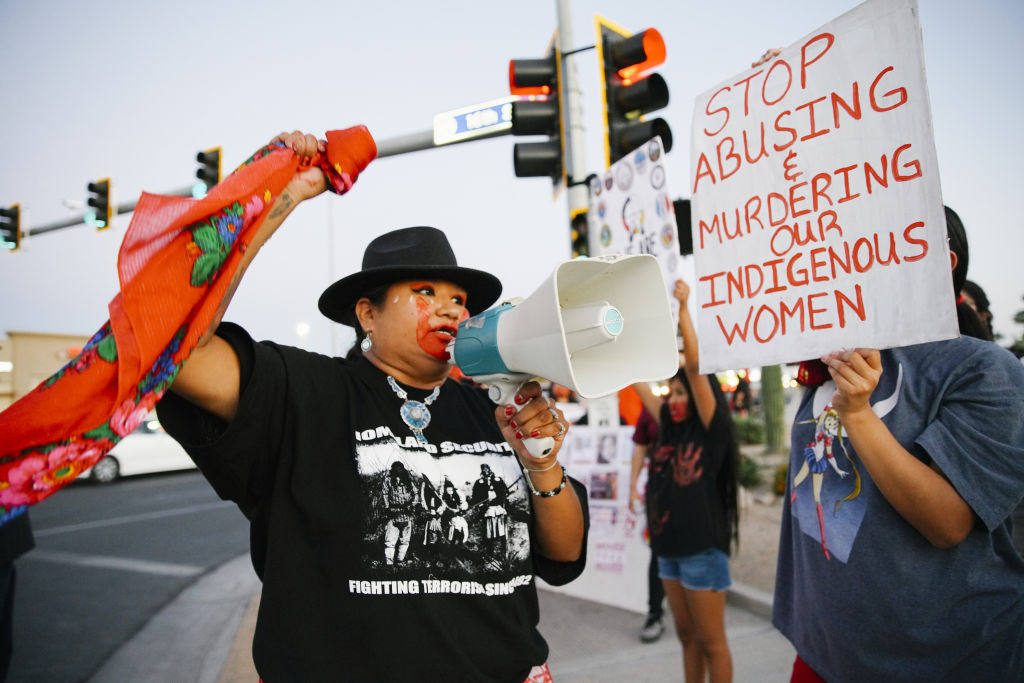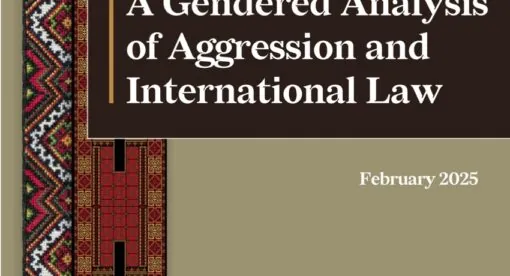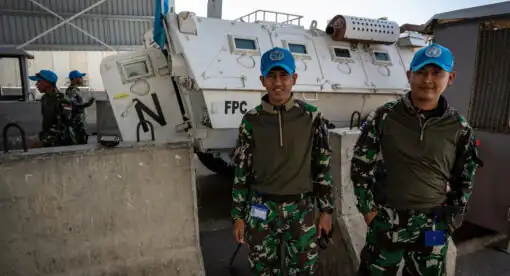As the U.S. looks to reposition itself as a competitive power and global leader on human rights, addressing gender-based violence (GBV) is a critical policy concern. GBV is not only an egregious and largely neglected human rights violation, it also threatens global economic growth and our collective security in the short and long term. Accordingly, prevention and response is and must continue to be elevated as an essential component to U.S. foreign policy and national security interests. While the Biden administration and key federal agencies are making significant strides, challenges remain in resource allocation and staff capacity to streamline interagency efforts.
Rates of GBV have spiked with the onset of COVID-19, compounded by issues such as climate change, resource scarcity, rising levels of conflict, and economic downturns. These interconnected issues foster insecurity, both physical and financial, that can increase levels of stress and fear within homes and communities, which often result in heightened violence for society’s most marginalized – largely women, girls, and individuals from diverse sexual orientation, gender identity, gender expression, and sex characteristics (SOGIESC) populations. Systemic racism and colonial legacies exacerbate the harms of GBV for people of color and indigenous communities, as they face both an increased risk and unequal access to justice and support systems.
Gender-based violence is an epidemic that impacts every society around the world. It is driven by gender inequality and can take many forms, including intimate partner violence; sexual violence and harassment; child, early, and forced marriage; and other manifestations of violence that are rooted in abuse of power and harmful norms. GBV results in immeasurable pain and loss, not only for individual survivors but also for families and whole communities, due to the interpersonal nature of GBV-related trauma and long-term impacts across the life course.
While GBV is exacerbated by physical and financial insecurity, the existence of such violence also heightens these insecurities. In the past year alone, conflict-related sexual violence has been used as a tactical method of war in Ukraine; online harassment of female political figures has undermined democracy as authoritarianism surges globally; and the Taliban continue to intensify their crackdowns on women’s rights in Afghanistan as part of their effort to consolidate power, including through invasive puberty exams and beatings.
In addition to the implications for peace and stability, widespread GBV has staggering impact on the global economy. The physical, mental, and emotional toll affects employees’ safety, attendance, and productivity – directly impacting the financial performance, reputation and resilience of businesses. According to U.N. Women, the cost of violence against women (public, private and social) amounts to $1.5 trillion worldwide. In some countries, even pre-pandemic, the World Bank estimated that GBV cost up to 3.7 percent of gross domestic product (GDP).
The failure to address the root causes of violence – namely, gender inequality – that undergird GBV will continue to exacerbate economic loss, increase insecurity, and further the erosion of human rights normative structures, all of which have an impact on the stability of a country.
U.S. Efforts to Address GBV Around the World
This December, in the wake of the 16 Days of Activism against Gender-Based Violence, the United States released its 2022 Update to the Strategy to Prevent and Respond to Gender-Based Violence Globally. A launch event to commemorate the milestone was hosted by the U.S. State Department’s Office of Global Women’s Issues, in coordination with the White House Gender Policy Council, and the U.S. Agency for International Development’s (USAID) Gender Equality and Women’s Empowerment Hub.
U.S. federal government commitments to preventing and responding to GBV around the world have expanded in the past decade, anchored in the release of the first iteration of this strategy in 2012 and subsequent update in 2016. The new global GBV strategy provides an interagency blueprint for the State Department and USAID to address the factors that increase the risks of GBV around the world and promote access to services and safety, particularly for those most in need. Strategies such as this are crucial to the Biden administration’s foreign policy objectives and work to reestablish American moral leadership on the global stage.
The 2022 strategy has the added benefit of deeper integration with other high-level strategies and plans in the U.S. GBV prevention and response is one of the 10 key priority areas highlighted in the U.S. National Strategy on Gender Equity and Equality; it is a key element in the Women, Peace, and Security Strategy that was codified into law in 2017; and it has been woven into and lifted up in several of President Joe Biden’s executive orders, such as the Executive Order on Improving Public Safety and Criminal Justice for Native Americans and Addressing the Crisis of Missing or Murdered Indigenous People.
Unique to this year’s strategy is the increasing recognition of the critical linkages between foreign and domestic security. Gender-based violence is a crisis that exists in our own backyard, and for too long, high-level federal action plans have only addressed this beyond our borders. The United States will soon release the first-ever domestic U.S. National Action Plan to End Gender-Based Violence, an initiative that serves to make good on the commitment of truly a whole-of-government approach to tackling the multifaceted scourge of GBV that is rampant both abroad and at home.
Historically, federal government efforts to address GBV have been criticized as being removed from the lived reality of survivors and the on-the-ground work of advocates and direct service providers who support them. However, the 2022 update largely builds upon the lessons learned from the critical and persistent work of survivors and activists who have called for federal government prevention and response efforts that are survivor centered and locally led, rather than structured around bureaucratic interests. The State Department and USAID spent years collecting feedback through a robust consultation process with over 450 individuals from 200+ organizations, representing civil society, bilateral and multilateral partners, the private sector, academia, implementing partners, U.S. government officials, and vitally, survivors themselves.
This administration is learning from other countries, especially in the Global South, in centering rights-based, public health-oriented approaches to the prevention and response to GBV, especially in culturally specific and historically exploited communities. For example, through coordinating the Trilateral Working Group on Violence Against Indigenous Women and Girls, the Biden administration turned to the governments of Mexico and Canada to exchange information about policies, programs, and promising practices to prevent and respond to violence against Indigenous women and girls. Additionally, the strategy is integrated with multilateral efforts on issues that intersect with GBV, such as disability rights and inclusion. The State Department and USAID drew upon commitments made at the 2022 Global Disability Summit to ensure GBV risk, mitigation, and response policies and programs are inclusive of and accessible to persons with disabilities.
Within the body of the document, the vision articulated at the outset is simply stated but powerful: to build a future free from gender-based violence for all people. Six guiding principles underlay the strategy itself – it is human rights-informed, intersectional, inclusive, survivor-centered, locally led, and takes a life course lens. These principles are reflected in much of the wider data and research on what works to prevent GBV. The complexity comes in the substance of the pillars, which outline how, when, and who will be responsible for ensuring that diplomatic relationships, foreign assistance investments, and programmatic decisions are accountable to the needs of survivors and work toward dismantling the root causes of violence that are threaded into systems and public institutions around the world, such as structural racism and poverty.
Compared to the 2012 strategy and the 2016 update, there is a stronger effort to center an intersectional lens, focusing on the disproportionate impact that people of color, people of diverse SOGIESC, and other historically marginalized and underserved populations face. This also includes providing GBV-specific services to young people, recognizing how the voices of girls and young women are often overlooked in decision-making about policies and programs that affect their daily lives. Additionally, the strategy draws deeper lines of collaboration across those working in humanitarian and international development fields while recognizing that GBV service provision should and must be contextually specific. Many conflict and humanitarian settings result in similar risks of GBV due to displacement and the breakdown of social structures, but not all service provision looks the same. In some areas of the world, particularly where same-sex relationships are criminalized, male survivors of sexual violence may in fact confront greater violence and trauma by reporting GBV and seeking services. Service provision must account for this stigma and heightened vulnerability in approaches to ensuring confidential care.
Overall, the 2022 update is much more than a bureaucratic document. It reflects genuine efforts on the part of the Biden administration’s Gender Policy Council, the State Department, and USAID to listen and adhere to the leadership of survivors and create institutional accountability. Further, it lifts up the utility of GBV prevention and response as a critical foreign policy and national security tool through the integration across interagency policy, diplomacy, and programming.
The U.S. government has made significant progress, yet much work remains. Far too many people continue to experience GBV over the course of their lives, and growing online threats and manifestations of GBV pose increasingly complex challenges. Despite these mounting difficulties, survivors, advocates, and activists around the world continue to fight. Their bravery and persistence in shining a light on the magnitude of this issue and holding public officials accountable has resulted in improved and more coordinated systems of response as well as the mobilization of a new generation.
As the Biden administration prioritizes building more resilient democracies, combating corruption, and defending human rights around the world, centering GBV in these conversations will be key to realizing these goals. It will also require continuing to draw collaborative lines of effort between foreign policy and national security institutions that bring meaningful policy solutions to the diverse needs of survivors around the world. By addressing the drivers that sustain and fuel GBV, the U.S. government can contribute to a cultural paradigm shift around dismantling gendered power imbalances.
Recommendations
- The Department of State and USAID should continue to increase sustained resources into GBV prevention and response, specifically for additional staff with gender expertise across all national security and foreign policy hubs, not just women’s departments and bureaus. They should mandate training on GBV in critical functional and geographic contexts beyond the already existing “gender 101” training. Without adequate distribution of well-trained staff with GBV expertise in government, institutional reforms to allocate GBV resources effectively and to integrate gender equity across foreign policy and assistance will not be realized.
- The Biden administration should continue to elevate GBV as a key foreign policy priority rather than a minor element of women’s rights or human rights issues by deepening the Gender Policy Council’s capacity and authority in high-level decision-making spaces. Additionally, the administration should push to amplify GBV in major foreign policy and national security documents (its mention in the NSS was a good start, albeit brief).
- Acting officials and delegated authority within the State Department and USAID should match increased resources with action across the interagency and continue to build relationships and initiatives that sync domestic and national security efforts. They should continue to develop systems that hold the government accountable, including streamlined feedback loops between civil society and key policy decision makers. The Secretary’s Office for Global Women’s Issues and USAID’s Gender Equality and Women’s Empowerment Hub should extend the advocate and survivor consultation sessions throughout the strategy’s implementation phase.
- The State Department and Biden administration should continue to build partnerships and invest resources and workforce capacity to address the changing nature of GBV in the modern landscape, specifically technology-facilitated GBV. The Global Partnership for Action on Gender-Based Online Harassment and Abuse is a testament to the multilateral and collaborative efforts to address GBV across borders. In addition to advancing comprehensive digital regulations and systems that protect women, girls, and gender-nonconforming persons who bear the brunt of this violence, the partnership should consider expanding research on the scale and scope of violent masculinity and misogyny that manifest online, and what works to prevent it.
Caroline Hayes is a Senior Strategic Initiatives Officer at Equimundo, where she oversees special projects and research related to masculinities, combating online radicalization, care equity, and violence prevention. Prior to joining Equimundo, Caroline worked in both policy and advocacy spaces on gender-based violence prevention with the U.S. Department of Justice and the Global Women’s Institute. She also spent several years focused on gender equality programming while serving in the United States Peace Corps in Morocco and at Vital Voices Global Partnership.
The views expressed in this article are those of the author and not an official policy or position of the New Lines Institute.






